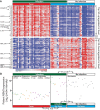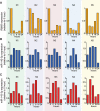RBM3 regulates temperature sensitive miR-142-5p and miR-143 (thermomiRs), which target immune genes and control fever
- PMID: 26825461
- PMCID: PMC4824108
- DOI: 10.1093/nar/gkw041
RBM3 regulates temperature sensitive miR-142-5p and miR-143 (thermomiRs), which target immune genes and control fever
Abstract
Fever is commonly used to diagnose disease and is consistently associated with increased mortality in critically ill patients. However, the molecular controls of elevated body temperature are poorly understood. We discovered that the expression of RNA-binding motif protein 3 (RBM3), known to respond to cold stress and to modulate microRNA (miRNA) expression, was reduced in 30 patients with fever, and in THP-1-derived macrophages maintained at a fever-like temperature (40 °C). Notably, RBM3 expression is reduced during fever whether or not infection is demonstrable. Reduced RBM3 expression resulted in increased expression of RBM3-targeted temperature-sensitive miRNAs, we termed thermomiRs. ThermomiRs such as miR-142-5p and miR-143 in turn target endogenous pyrogens including IL-6, IL6ST, TLR2, PGE2 and TNF to complete a negative feedback mechanism, which may be crucial to prevent pathological hyperthermia. Using normal PBMCs that were exogenously exposed to fever-like temperature (40 °C), we further demonstrate the trend by which decreased levels of RBM3 were associated with increased levels of miR-142-5p and miR-143 and vice versa over a 24 h time course. Collectively, our results indicate the existence of a negative feedback loop that regulates fever via reduced RBM3 levels and increased expression of miR-142-5p and miR-143.
© The Author(s) 2016. Published by Oxford University Press on behalf of Nucleic Acids Research.
Figures






Similar articles
-
Regulation of the MIR155 host gene in physiological and pathological processes.Gene. 2013 Dec 10;532(1):1-12. doi: 10.1016/j.gene.2012.12.009. Epub 2012 Dec 14. Gene. 2013. PMID: 23246696 Review.
-
TLR-4/miRNA-32-5p/FSTL1 signaling regulates mycobacterial survival and inflammatory responses in Mycobacterium tuberculosis-infected macrophages.Exp Cell Res. 2017 Mar 15;352(2):313-321. doi: 10.1016/j.yexcr.2017.02.025. Epub 2017 Feb 16. Exp Cell Res. 2017. PMID: 28215633
-
Increased miR-424-5p expression in peripheral blood mononuclear cells from patients with pemphigus.Mol Med Rep. 2017 Jun;15(6):3479-3484. doi: 10.3892/mmr.2017.6422. Epub 2017 Apr 3. Mol Med Rep. 2017. PMID: 28393203 Free PMC article.
-
Surfactant protein D induces immune quiescence and apoptosis of mitogen-activated peripheral blood mononuclear cells.Immunobiology. 2016 Feb;221(2):310-22. doi: 10.1016/j.imbio.2015.10.004. Epub 2015 Oct 28. Immunobiology. 2016. PMID: 26563748
-
Cellular Functions of RNA-Binding Motif Protein 3 (RBM3): Clues in Hypothermia, Cancer Biology and Apoptosis.Protein Pept Lett. 2016;23(9):828-35. doi: 10.2174/0929866523666160628090340. Protein Pept Lett. 2016. PMID: 27364162 Review.
Cited by
-
Neuroprotection via RNA-binding protein RBM3 expression is regulated by hypothermia but not by hypoxia in human SK-N-SH neurons.Hypoxia (Auckl). 2017 May 23;5:33-43. doi: 10.2147/HP.S132462. eCollection 2017. Hypoxia (Auckl). 2017. PMID: 28580361 Free PMC article.
-
Cold stress protein RBM3 responds to hypothermia and is associated with good stroke outcome.Brain Commun. 2020 Jun 4;2(2):fcaa078. doi: 10.1093/braincomms/fcaa078. eCollection 2020. Brain Commun. 2020. PMID: 33585816 Free PMC article.
-
RNA binding motif protein 3 (RBM3) promotes protein kinase B (AKT) activation to enhance glucose metabolism and reduce apoptosis in skeletal muscle of mice under acute cold exposure.Cell Stress Chaperones. 2022 Nov;27(6):603-618. doi: 10.1007/s12192-022-01297-7. Epub 2022 Sep 23. Cell Stress Chaperones. 2022. PMID: 36149580 Free PMC article.
-
Non-coding RNAs in Natural Killer/T-Cell Lymphoma.Front Oncol. 2019 Jun 13;9:515. doi: 10.3389/fonc.2019.00515. eCollection 2019. Front Oncol. 2019. PMID: 31263681 Free PMC article. Review.
-
Robust RBM3 and β-klotho expression in developing neurons in the human brain.J Cereb Blood Flow Metab. 2019 Dec;39(12):2355-2367. doi: 10.1177/0271678X19878889. Epub 2019 Sep 29. J Cereb Blood Flow Metab. 2019. PMID: 31566073 Free PMC article.
References
-
- Leon L.R. Invited review: cytokine regulation of fever: studies using gene knockout mice. J. Appl. Physiol. 2002;92:2648–2655. - PubMed
-
- Ogoina D. Fever, fever patterns and diseases called ‘fever’–a review. J. Infect. Public Health. 2011;4:108–124. - PubMed
-
- Greer D.M., Funk S.E., Reaven N.L., Ouzounelli M., Uman G.C. Impact of fever on outcome in patients with stroke and neurologic injury: a comprehensive meta-analysis. Stroke. 2008;39:3029–3035. - PubMed
-
- Young P., Saxena M., Beasley R., Bellomo R., Bailey M., Pilcher D., Finfer S., Harrison D., Myburgh J., Rowan K. Early peak temperature and mortality in critically ill patients with or without infection. Intensive Care Med. 2012;38:437–444. - PubMed
Publication types
MeSH terms
Substances
LinkOut - more resources
Full Text Sources
Other Literature Sources
Medical
Molecular Biology Databases

